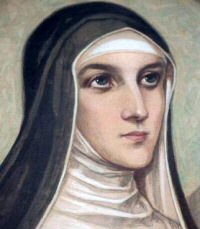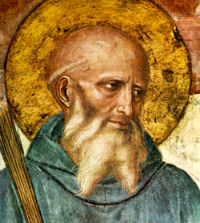
Hosea 2:16bc, 17cd, 21-22
Psalm 15
Revelation 19:1, 5-9a
Luke 10:38-42
How Little We Know
In a hymn composed some years ago for today's feast, a Benedictine friend of mine addressed Saint Scholastica, saying:
How little do we know
revealing who you are:
this silence, born of peace,
perhaps speaks even more.
Into The Treasury of the Liturgy
Apart from a few precious pages in the Dialogues of Saint Gregory, we know nothing of Saint Scholastica. The little revealed by Saint Gregory has, nonetheless, inspired an astonishing richness of liturgical texts: antiphons, responsories, hymns, and prayers. Like miners in search of a vein of pure gold, anonymous poets through the ages have extracted from Saint Gregory's few pages the raw material of chants and prayers that, even today, delight us and draw us into the heavenward flight of Scholastica, the pure dove.
There is so much to see, to hear, to taste, to smell:
-- psalms of praise sung around a table, men's and women's voices in antiphony;
-- the breaking of bread and the fragrance of wine poured out;
-- the impassioned sound of Mediterranean conversation;
-- two saints locked in a holy difference of opinion;
-- Scholastica';s hands folded upon the table;
-- her head bowed and resting upon her hands;
-- her tears flowing freely;
-- the pentecostal wind, the crash of thunder and blaze of lightning;
-- the torrential downpour, heaven's answer to a woman's tears.

The Upward Flight of the Dove
In the end, Saint Gregory leaves us with the image of the dove, dazzling white in flight, disappearing into the light, and with the sound of Saint Benedict's voice raised in praise. That perhaps is more than enough for us, but in the readings of today's Mass we are given still more.
Bethany
The liturgy, wildly lavish -- precisely because it is the gift of a God lavish in love, offers us today a kind of triptych, three icons hinged together. At the center is the icon painted by Saint Luke. See Jesus seated in the holy house of Bethany. At his feet, see Mary, fixed in the stability of love, listening intently, the words of the Word falling into the open vessel of her heart. In the background, see Martha, bustling with anxious energy, fragmented and mobilized by a multitude of cares and, for all of that, conscious enough of the presence of Jesus to address her complaints to him and to no other.
In the School of Christ
The scene is both strangely the same and yet different from the one described by Saint Gregory. In the Dialogues, the meal has already taken place, the bread has been broken and the darkness has fallen. In the Gospel the meal has yet to take place but Jesus, anticipating the breaking of bread, is feeding Mary with his Word, causing the brightness of his glory to shine like the daystar in her heart. Christ is the Benedictus, the Blessed of the Father, speaking blessings, -- bene dicere -- uttering the good things that proceed from the goodness of his heart. Mary is the Scholastica, having placed herself in the schola Christi, the school of Christ. Martha, caught betwixt fear and freedom, is the tension between life's regular demands -- those of the Regula, the Rule -- and the surpassing primacy of a love set free from fear.
A Door of Hope in the Desert
To the left of the central panel is an icon having, at first glance, none of the comforting warmth of Saint Luke's domestic scene. It depicts the desert, the archetypical monastic setting. We see the bride wooed by Love into the desert only to discover there a gift of vineyards and, in the valley of Achor (meaning "trouble") a door of hope. Scholastica, having inclined the ear of her heart to the Word becomes, in the desert, the sponsa Verbi, the bride of the Word. She passes through the door of hope opened by the Bridegroom and invites us to follow in her steps.
What God Has Prepared for Those Who Love Him
The third panel could not be more different from the first. It reveals what lies beyond the desert, mysteries prepared on the other side of the door of hope: "what no eye has seen, nor ear heard, nor the heart of man conceived, what God has prepared for those who love Him" (1 Cor 2:9). An icon speaks to the eyes, shimmering with the light of heaven, and yet, if you put your ear to it in lectio divina, you will hear "the voice of a great multitude, like the sound of many waters and like the sound of mighty thunderpeals" (Ap 19:6). Waters and thunderpeals again! Images borrowed by Saint Gregory!
The Time of Singing Has Come
Listen closely: you will hear the sound of voices rejoicing at the marriage supper of the Lamb. There is the voice of a man; it is that of Benedict celebrating the triumph of Love. There is the voice of a woman; it is Scholastica singing a song never to be interrupted. "Lo, the winter is past, the rain is over and gone . . . the time of singing has come" (Ct 2:11-12). Today, Scholastica and Benedict together invite us to the Supper of the Lamb.


